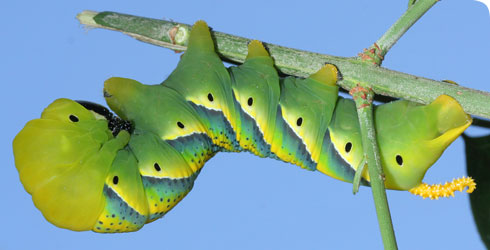Life cycle
The moth’s egg is oval, pale bluish-green and smooth to the naked eye. Under high magnification, you can see a fine network of polygonal cells. It changes to a yellowish colour prior to hatching.
The first instar larva is pale green with a very long, black, anal horn that has a slightly forked tip.
In the second instar, the horn shortens and turns pale yellow; the surface of the horn and body becomes covered with minute pale tubercles.
By the third instar, the 7 oblique lateral stripes typical of many hawkmoth caterpillars are fully developed. They are white and edged above with blue-grey. The horn starts to recurve dorsally and the tubercles on it and the front part of the body become larger. Overall, the caterpillar becomes more yellow.
In the fourth instar, this yellow tone becomes more vivid and the horn recurves further.
In the fifth and final instar, the tubercles are lost, except from the horn, which is now strongly recurved. The blue edging of the lateral stripes often becomes extensive, forming a series of broad, V-shapes along the back.
There are also 2 other, less common colour forms. One is green rather than yellow. The other is very different, with an overall mottled brown colour and no trace of the oblique stripes. There is a broad, whitish patch behind the head and the whole effect is of a very large bird dropping.
When young, the caterpillar rests along a vein under a leaf and nibbles small holes in the leaf surface. Later, it is too heavy to do this and has to rest along a leaf stalk or small branch.
The caterpillars are not very active. They move only to find a new leaf after they finish the one they are on. If disturbed, the caterpillars gnash their formidable mandibles, making a loud clicking noise, and thrash about in an attempt to bite their attacker.
Acherontia atropos caterpillars eat a wide range of plants, but mostly those in the plant orders Lamiales and Solanales. The former includes such families as Bignoniaceae, Oleaceae (privet and lilac are readily eaten in captivity) and Verbenaceae; the latter includes Solanaceae.
Historically, caterpillars and pupae were often found in potato fields. However, due to widespread use of chemical sprays and mechanical harvesting, this is no longer the case.
Death’s-head hawkmoth caterpillars have been found feeding on over 100 genera of plants, including cannabis (Cannabis sativa) and deadly nightshade (Atropa belladonna).
When full-grown at 12–13cm long, the caterpillar darkens and covers itself with a saliva-like secretion. It wanders in search of somewhere to pupate.
Once it has found a suitable place, the caterpillar burrows down 15–40cm and pupates in an oval, smooth-sided cavity. The pupa is 7–8cm long, smooth, deep chestnut-brown and very active, wriggling from side to side if disturbed. The pupa is generally the overwintering stage but cold winters kill it and it rarely survives outdoors in the UK.
